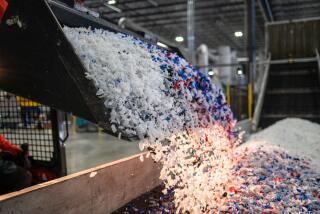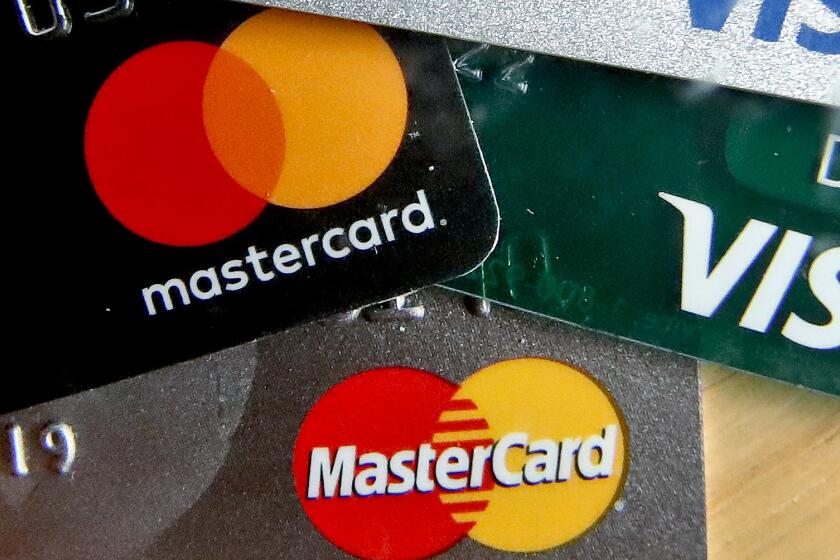Need for Security Makes Shredding Booming Business
- Share via
Lt. Col. Oliver North’s $7,000 government-issue paper shredder was quick--it could chop one sheet of paper into 10,000 pieces in a second. But it was hardly high-tech or high volume when compared to document-shredding equipment used by firms in the records destruction business.
Many document destruction workers travel in mobile units using Department of Defense-approved machinery that shreds, pounds and bales papers into a fibrous material small enough to be eaten by worms.
North’s model, which he and secretary Fawn Hall used to shred documents relating to the Iran-Contra investigation, is popular in corporate suites. But it could take only 12 sheets of standard paper at a time, and it couldn’t chop microfilm. Destruction firms like Paper Recovery of Orange use advanced, microfilm-destroying machines that can shred three tons of paper in an hour.
Aerospace contractors, pharmaceutical makers and utilities, all with enormous amounts of confidential material, are the biggest customers of the 10 or so destruction firms in Orange and Los Angeles counties.
Are More Leery
As computers produce greater volumes of paper and storage space becomes more expensive, businesses are destroying more documents than ever, according to Linda Masquefa, a spokeswoman for Schick Moving & Storage in Tustin. And, fearing that documents might end up in the wrong hands, business managers are more leery than ever about simply dumping documents into the trash.
And, document destructors say, North’s now famous use of a Datatech Intimus 007 shredder has heightened interest in records destruction and brought in more business than ever.
“People want to know that their confidential records aren’t sitting around where they might be read by everybody,” said Vic Castillo, a vice president of Paper Recovery and its Data Records Destruction division, which has offices in Santa Ana, San Diego and San Jose.
Data Records picks up documents, destroys them at a Data Records plant, and sends the customer a “certificate of destruction,” according to Terry Loftus, a regional vice president for Paper Recovery in Orange County.
John Newman is “Mr. Destroyer” to workers at Document Disintegration in Gardena. In 1966, Newman came out of the Marine Corps and started with the company as driver of a then newly assembled, $125,000 mobile destruction unit.
Dawn of a New Era
Now chief of operations, Newman recently spent $100,000 renovating the same truck. In his 20 years on the job, Newman has watched the dawn of a new era as long sheets of computer paper eventually replaced key punch cards as the biggest item for destruction.
Golden State Fibres, a document destruction firm in Canoga Park, has spent $1.1 million building a high-tech, mobile document destruction unit that will be on the streets by February, according to Barbara Collet, who owns the firm with her husband, Tom.
Collet said that the truck has received Defense Department approval for destroying government documents--which requires that destructors macerate paper into pieces one-thirty-second by one-sixty-fourth of an inch.
It took the Collets five years to get financing to assemble the truck, but “finally we were able to convince the lender that we were in a strong, growing industry,” Barbara said.
Golden State, which destroyed 1,700 tons of documents in 1987, plans to cruise from Santa Barbara to San Diego, picking up records at small firms that don’t have destruction companies in their towns.
Customers using the truck will be charged between 10 cents and 20 cents a pound for document destruction, compared to 3 cents to 4 cents per pound for jobs done at the company’s Canoga Park facility.
Once pummeled, the insulation-like product can take on new life. Data Records ships the final, baled product to a mill. Other destruction businesses send their product off to a dump or overseas, where recyclable paper gets a higher price than in the United States.
Still others sell their destroyed, fibrous paper to insulation makers or worm farmers.
“The worms eat it--they like newsprint. It produces huge worms and they fertilize the ground,” said Lawrence Harris, vice president of Pacific Paper Cutter, a shredder retailer in Los Angeles.
Southern California’s largest corporations have internal document destruction equipment, in addition to sending records out for destruction.
Sales of document destroyers to businesses have grown about 14% each of the past five years, and in 1987, U.S. businesses spent $125 million installing their own paper shredders, according to Ray Allegrezza, editor of Office World News, a monthly magazine in Garden City, N.J.
$99 to $8,500
Companies ranging from Allergan Pharmaceuticals to American Honda have state-of-the-art machines that shred, pummel and macerate paper products. Allegrezza said machines run from $99 for very simple paper shredders, to $8,500 for the sharpest-bladed electronic destroyers.
“These could crush you and me in a second,” Allegrezza said.
Desk-top shredding is common in executive suites, according to Louis Snyder, a spokesman for the Assn. of Records Managers and Administrators in Prairie Village, Kan.
At American Honda in Gardena, the importance of keeping confidential documents protected until they can be destroyed has become so important that locked trash cans are next to some copy machines, according to Janet Skillman, a records manager at Honda. The paper in the trash cans is sent straight to the shredder.
Linda Cusimano, supervisor of records management at Allergan in Irvine, said many documents are destroyed on premises, and the company has a file cleaning day each year when documents are collected and sent to an outside destruction firm.
Many businesses declined to discuss their record destruction procedures for fear of revealing too much to competitors.
Popular for Home Use
Paper shredders have even become popular for home use--with schoolteachers and homeowners buying low-price models, retailers said.
But no shredder could have worked fast enough for the “repentant occult worshiper” who demanded that his mystic books and writings be destroyed instantly, according to Malcolm Dunn, a vice president at Document Disintegration.
“I wanted to help him, but he just couldn’t afford it,” Dunn said.
The document destruction business hasn’t boomed for everyone. Ray Mieirs, owner of Mieirs Leasing in Fullerton, invested $14,000 in destruction equipment in 1985 but got out of the business last year because it was too costly.
“It costs a lot to go out and get the business,” Mieirs said.
Dunn at Document Disintegration said: “It’s not always easy knowing where the business is. Finding repenters who want to destroy everything isn’t an easy job.”
More to Read
Inside the business of entertainment
The Wide Shot brings you news, analysis and insights on everything from streaming wars to production — and what it all means for the future.
You may occasionally receive promotional content from the Los Angeles Times.










